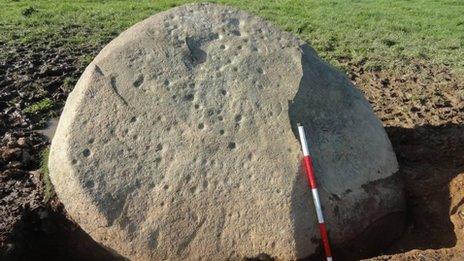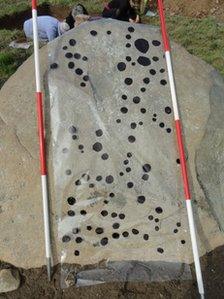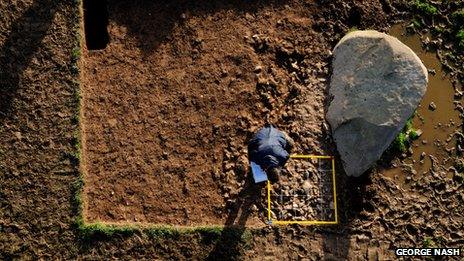Trefael Stone reveals stone age burial chamber
- Published

The Trefael Stone, seen here with a metre-long measuring stick, is probably the capstone of a Stone Age burial chamber
Archaeologists are to exhume and analyse human bones found under a prehistoric monument only recently identified as a burial site cap.
The Trefael Stone in Pembrokeshire was thought to be just one of many linked to nearby Bronze Age locations.
But it has now been reclassified after a survey established it as the capstone of a Stone Age ritual burial chamber.
The survey revealed the location, near Nevern, has been used for ritual burials for at least 5,500 years.
An archaeological team from the University of Bristol has been given permission to examine the human bones found there along with beads and shards of pottery.
The importance of the stone has been overlooked since it first appeared on maps in 1889.
The first suggestion it may be more significant than one of Wales' many prehistoric standing stones was in 1972 when archaeologist Frances Lynch suggested it could be a dolmen, or burial chamber.
University of Bristol visiting fellow Dr George Nash and colleagues Thomas Wellicome and Adam Stanford held an excavation in September 2010 and returned again last year.

The research found a number of new cupmarks, as shown by the tracing
As well as unearthing the human remains, beads and pottery, they found a stone cist - a half-metre long coffin-like container - which they estimate was put there in the later Bronze Age.
The find indicates the site may have been reused as a burial location long after the original stone chamber was built.
Their findings suggest it may prove to be Wales' earliest Neolithic ritual burial location and one of the earliest in Western Europe.
Dr Nash said he knew of Lynch's 1972 comment on the stone, and that no geophysical survey or excavation had been carried out.
He said: "I've always had this hunch that it could be much bigger. It's extremely exciting. It's one of those once-in-a-lifetime finds."
The stone is already noted for a number cupmarks or circular holes gouged out during its ritual use in the Neolithic and Bronze Age ceremonies.
The archaeologists found a further 30 cupmarks of varying size on the 1.2m high stone.
Dr Nash said they were able to establish the site was stone burial chamber, built from giant boulders, going back to around 3,500 BC, which was then dismantled about 2,000 BC.
The capstone was then used as a procession marker standing stone pointing to nearby Bronze Age locations he said.

The Trefael Stone, seen here during an excavation, is probably the capstone of a Stone Age burial chamber
The beads suggest the location may be associated with burials long before even the burial chamber was built, as they may relate to a nearby Mesolithic site dating back 10,000 years, he said.
Dr Nash said the team were amazed that any artefacts were found at the site given the acidic nature of the soil, centuries of agriculture and the area's popularity over the generations with people seeking to unearth ancient treasures.
Dr Nash said: "The soils around this site are very acidic, so I'm astonished how the pottery and the bones have survived all this time.
"It's a big problem in Wales because of a lot of sites have been excavated by antiquarians who have just dug a hole looking for goodies, then taken what they want but have wrecked the site.
"What we have found is extremely rare."
Rock art
The Royal Commission on the Ancient and Historical Monuments of Wales has updated its records on the basis of Dr Nash's work.
Dr Nash said the Ministry of Justice had since licensed the team to remove the bones for analysis, including radiocarbon dating, when they return to the site in September.
The Trefael Project is run by members of the Welsh Rock Art Organisation (WRAO), which is a member of the International Federation of Rock Art Organizations (IFRAO).
WRAO is a non-profit research body specially interested in the researching and promoting prehistoric rock art in Wales.
- Published24 April 2012
- Published7 April 2012
- Published15 October 2011